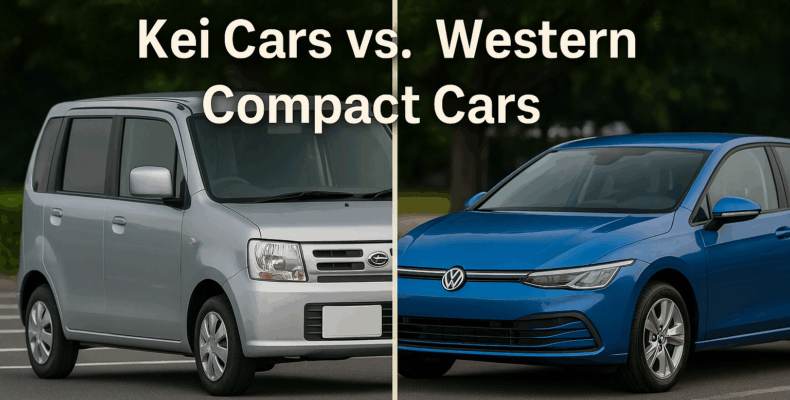Kei cars, also known as “keijidōsha” in Japan, are uniquely small, efficient, and affordable. Western compact cars, on the other hand, are slightly larger and often offer more power. But which is better for today’s drivers? In this article, we compare Japanese kei cars and Western compact cars based on size, fuel economy, cost, features, and export value.
1. Size and Maneuverability
Kei Cars (Japan)
-
Built to meet strict Japanese regulations: max 660cc engine, length under 3.4 meters
-
Extremely compact and easy to park
-
Ideal for crowded cities and narrow roads
Western Compacts
-
Typically larger (1.0–1.5L engines, longer body)
-
Still smaller than mid-size cars, but less maneuverable than kei cars
-
Better for highways and longer commutes
Conclusion:
Kei cars win in urban settings, while Western compacts offer more space for passengers and cargo.
2. Fuel Efficiency
Kei Cars
-
Lightweight and small engines = excellent fuel economy
-
Many models reach over 20–25 km/L
-
Mild hybrid options are becoming common
Western Compacts
-
Efficient for their size, especially diesel and hybrid versions
-
Generally get 15–20 km/L
-
Heavier weight affects overall mileage
Conclusion:
Kei cars are more fuel-efficient, especially for short trips and city driving.
3. Price and Maintenance
Kei Cars
-
Low purchase price and tax in Japan
-
Maintenance is simple and affordable
-
Insurance and registration costs are also lower
Western Compacts
-
Higher initial price
-
Parts may be more expensive and complex
-
Maintenance intervals are longer but pricier
Conclusion:
Kei cars are better for budget-conscious buyers and first-time car owners.
4. Features and Performance
Kei Cars
-
Basic interiors and lower horsepower (40–60hp)
-
Designed for efficiency, not speed
-
Newer models include airbags, ABS, and basic infotainment
Western Compacts
-
More power (80–150hp) and highway stability
-
Advanced features like adaptive cruise control and larger displays
-
Smoother ride on highways
Conclusion:
Western compact cars are stronger in performance and tech, but kei cars are improving quickly.
5. Export Value and Popularity
Kei cars are gaining popularity overseas, especially in the U.S., Canada, and Southeast Asia due to their:
-
Low cost
-
Unique style and charm
-
Off-road customization potential
Western compact cars are widely accepted globally, but kei cars stand out in niche markets.
Trusted Exporters of Japanese Kei Cars
If you’re considering importing a kei car, it’s important to choose a trusted exporter who understands shipping regulations and customer needs.
-
EVERY Co., Ltd.
Based in Niigata, Japan, EVERY has exported thousands of kei cars and trucks since 2006. Known for fast response, honest listings, and multilingual support.
➤ https://www.everycar.jp/ -
SBT Co. Ltd.
Offers a wide range of compact Japanese vehicles with inspection reports. -
Be Forward
One of the largest exporters with global coverage and strong after-sales support. -
Qualitex Trading
Known for customized kei trucks and affordable pricing. -
Autorec Enterprise Ltd.
Long-established company with strict quality checks and global logistics experience.
➤ Read more here:
Top Recommended Japanese Used Car Export Companies for International Customers
Final Thoughts
If you’re looking for a city-friendly, cost-effective, and fuel-efficient vehicle, kei cars are hard to beat. However, if you need more power, space, or features for long drives, a Western compact car may be a better fit.
In the end, both offer unique advantages depending on your location, needs, and budget.
